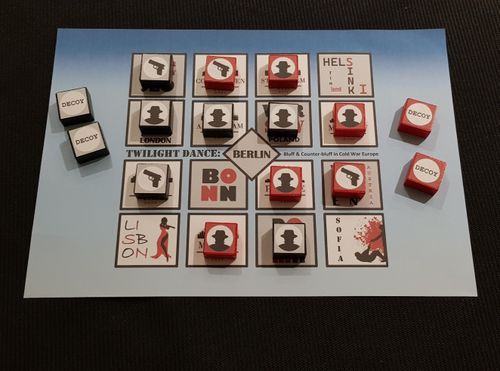|
Advertisement
|
Twilight Dance: Bluff & Counter Bluff in Cold War Europe

Description“TWILIGHT DANCE is a Cold War themed ‘worker placement’ chaining game, in which two adversaries take turns to place and move hidden identity playing pieces on a four by four grid featuring sixteen European capitals. The city of Cold War Berlin is represented by an additional special space in the centre of the board.” What the two adversaries need to play:
Objective of the game and how to play: Pieces are played to the board, which is a 4-by-4 grid forming a schematic representation of key European Cold War capitals, with the city of Berlin represented by an additional ‘special’ space in the middle of the board. The cities represented - in addition to Berlin - are Oslo, Copenhagen, Stockholm, Helsinki, London, Amsterdam, Warsaw, Moscow, Paris Bonn, Prague, Vienna, Lisbon, Madrid, Rome and Sofia. Players can do one of the following five things on their turn: [*Note: If a piece is shunted off the board, it enters the other player’s hand, irrespective of allegiance.] Scoring examples are illustrated in the rules located in the files section. Notes on restrictions and other essential rules: Players cannot forego their turn if they possess unplaced pieces. ‘Shunting’ is orthogonal from the 16 cities comprising the 4-by-4 board. It is diagonal from Berlin. A piece passed to a player as a result of shunting should not be examined by the shunting player. The player receiving the piece will be able to look at its hidden side once it is in their hand. Pawns and stacking —description from the designer Game DiscussionsAdd CommentYou need to be logged in to comment. Insert Bullet List Please enter at least one item. Item: Item: Item: Item: Item: Insert Numeric List Please enter at least one item. Item: Item: Item: Item: Item: Insert Link Please enter the link of the website Optionally you can add display text Insert Email Please enter the email address Optionally add any display text Insert Image Please enter the link of the image Insert YouTube Video Please enter the link of the video Marketplace | ||||

Comments (0)